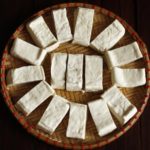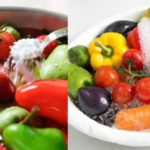The practice of soaking vegetables in salted water stems from the belief that it kills bacteria. While salt does have antibacterial properties, this method is not as effective as once thought, and experts now advise against it. Salt water does not kill parasites, and unless the solution is extremely salty, it will only cause the vegetables to lose water, becoming limp and less sweet while also providing an entry point for bacteria.
Therefore, soaking vegetables in salt water is an outdated practice that should be avoided. Ms. Jin Jin, a nutritionist at the Clinical Nutrition Department of Beijing University International Hospital in China, recommends the following alternative methods to effectively clean fruits and vegetables:
Rinse under running water
Rinsing vegetables under running water is the best way to remove dirt, chemicals, and pesticides. Instead of filling a large basin, hold the vegetables directly under the tap and use your hands to gently rub off any visible dirt. This method ensures that bacteria, parasites, and dirt are washed away. If possible, rinse each fruit or vegetable individually. The pressure from the running water helps dislodge dirt, which then washes away down the drain. After rinsing, soak the vegetables for about 10 minutes to help break down any remaining toxins, and then rinse again several times.

Rinsing under running water is recommended
Soak vegetables in a high-alkaline solution
Alkaline water has excellent disinfecting properties. You can use water from an alkaline water machine or purchase alkaline powder on the market. After rinsing off any visible dirt, soak the fruits and vegetables in the alkaline solution for 5-15 minutes, and then rinse them with clean water 3-5 times. The ideal pH level for effective disinfection is between 10 and 12.
Peel the skin
While the skin of fruits and vegetables contains many nutrients, it is also where parasites, dirt, and bacteria are most likely to be found. If you are concerned or unsure about the origin of the produce, it is best to peel the skin. Some fruits and vegetables that are recommended to be peeled include apples, pears, kiwis, cucumbers, carrots, eggplants, pumpkins, zucchini, and beets.
Blanching
Blanching vegetables in boiling water can help remove impurities. If you are cooking the vegetables, it is advisable to blanch them first. This is especially true for beans, leafy greens, and broccoli. Blanching can help break down chemicals and pesticides. To blanch, prepare a pot of boiling water in a sufficient amount for the quantity of vegetables. Then, add the vegetables for 1-3 minutes, depending on the type, before removing them and rinsing them again. Only then should they be cooked further by boiling, stir-frying, or steaming.

Blanching is an effective way to remove impurities before cooking
Don’t eat produce immediately after purchasing
Over time, chemicals will naturally degrade. This is why farmers must wait a certain period after applying pesticides before harvesting. However, this waiting period is sometimes ignored. Therefore, if the fruit or vegetable has a long shelf life, it is advisable to wait a few days before consuming it. The oxygen in the air and enzymes in the produce will react and help break down pesticides, reducing the risk of consuming these chemicals.
Wash with baking soda
Baking soda is not just for baking; it’s also an effective cleaning agent. If you have food-grade baking soda, you can mix it with water and soak your fruits and vegetables in the solution. Baking soda creates an alkaline environment when mixed with water, which helps disinfect and break down pesticides more effectively than salt water. First, rinse the produce under running water, then soak them in the baking soda solution for about 20 minutes, and finally, rinse them again.






































